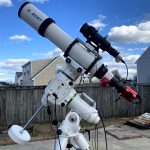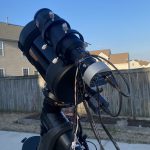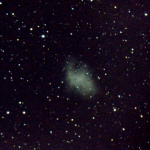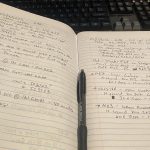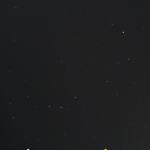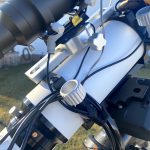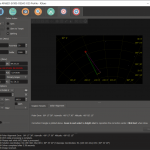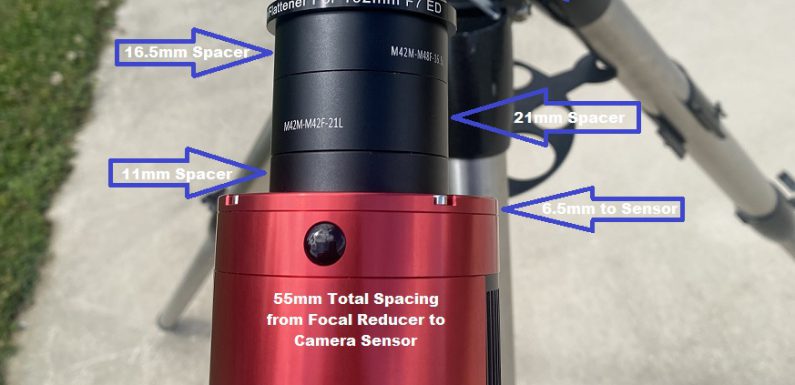
I have made a lot of notes in my logs around spacing when using Focal Reducers with my SV305 and ZWO ASI294MC Pro cameras for EAA. This post is just to document I how set up the spacing for the focal reducers on my SCT and refractor setups to hopefully help others doing the same for either EAA Observing or Astrophotography.
A focal reducer uses a positive lens to shorten the focal length of a telescope by causing the incoming light to converge quicker. This also decreases the effective focal ratio of the telescope. Many focal reducers also act as field flatteners which correct field curvature and coma of the objective lens. There is a great guide to focal reducers at Agena Astro which provides some details on the different types of focal reducers and how they work.
Don’t forget about the sensor depth (from the camera body to the sensor) when calculating the backspacing. For reference the ZWO ASI 294MC Pro Camera has a sensor depth of 6.5mm and my SVBONY SV305 has a sensor depth of 11.5mm.
SVBONY SV193 0.8 Reducer/Flattener on the SVBONY SV503 102mm Refractor
SVBONY SV193 .8 Reducer/Flattener for the SV503 102ED Refractor
Target backspacing is 55mm between Focal Reducer and Camera Sensor to achieve the full 0.8 reduction.
The SV193 reduces the focal length of the SV503 102ED by 0.8. This takes the focal length from 714mm to 571mm which decreases the focal ratio from F/7 to F/5.6 (focal length / aperture = focal ratio or 517 / 102 = 5.6).
For the correct spacing using the SVBONY SV193 Focal Reducer to the ZWO ASI294 camera it is set up like this: Focal Reducer to 16.5mm spacer + 21mm Spacer + 11mm Camera Adapter + 6.5mm to camera sensor = 55mm
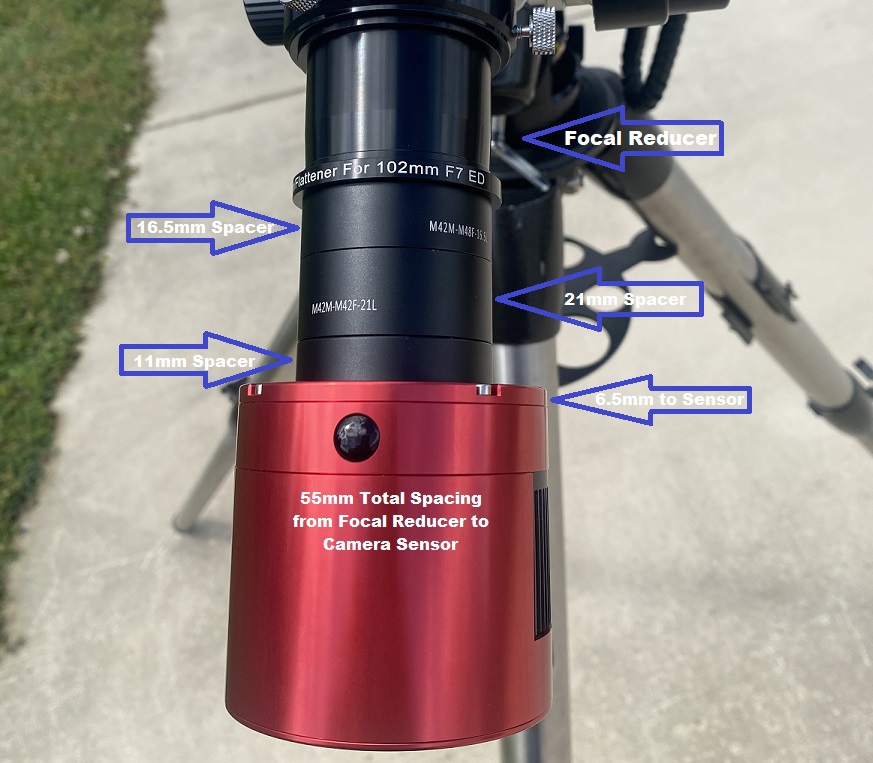
With this spacing between the focal reducer and the camera the plate solving in Ekos is calculating the focal length to be 569mm and a focal ratio of F/5.6, so I am pretty spot on. The field is nice and flat across the entire FOV, no distortion or vignetting at the edge or corners.
Celestron F/6.3 Reducer on the 6″ or 8″ SCT
Celestron F/6.3 SCT Focal Reducer for both the Celestron C6 and Celestron C8 SCT
Target spacing is 105mm between Focal Reducer and Camera Sensor to achieve full reduction.
Without a focal reducer both the Celestron 6″ and Celestron 8″ SCT scopes have a focal ratio of F/10. The Celestron F/6.3 SCT Focal Reducer threads directly on to the back of the SCT, then the SCT T-Adapter (93633-A) threads onto the focal reducer, then the spacers, and finally the camera. You can determine the focal length by multiplying the aperture by the focal ratio, for example the 6″ (152mm) SCT at F/6.3 would have an effective focal length of 957.6mm (152mm x 6.3 = 957.6mm)
For the correct spacing between the F/6.3 focal reducer and the ZWO ASI294 camera use the following: Focal Reducer threaded directly onto the SCT rear threads then the 50mm SCT T-Adapter (93633-A) + 16.5mm Spacer + 21mm Spacer + 11mm Camera Adapter + 6.5mm to camera sensor = 105mm
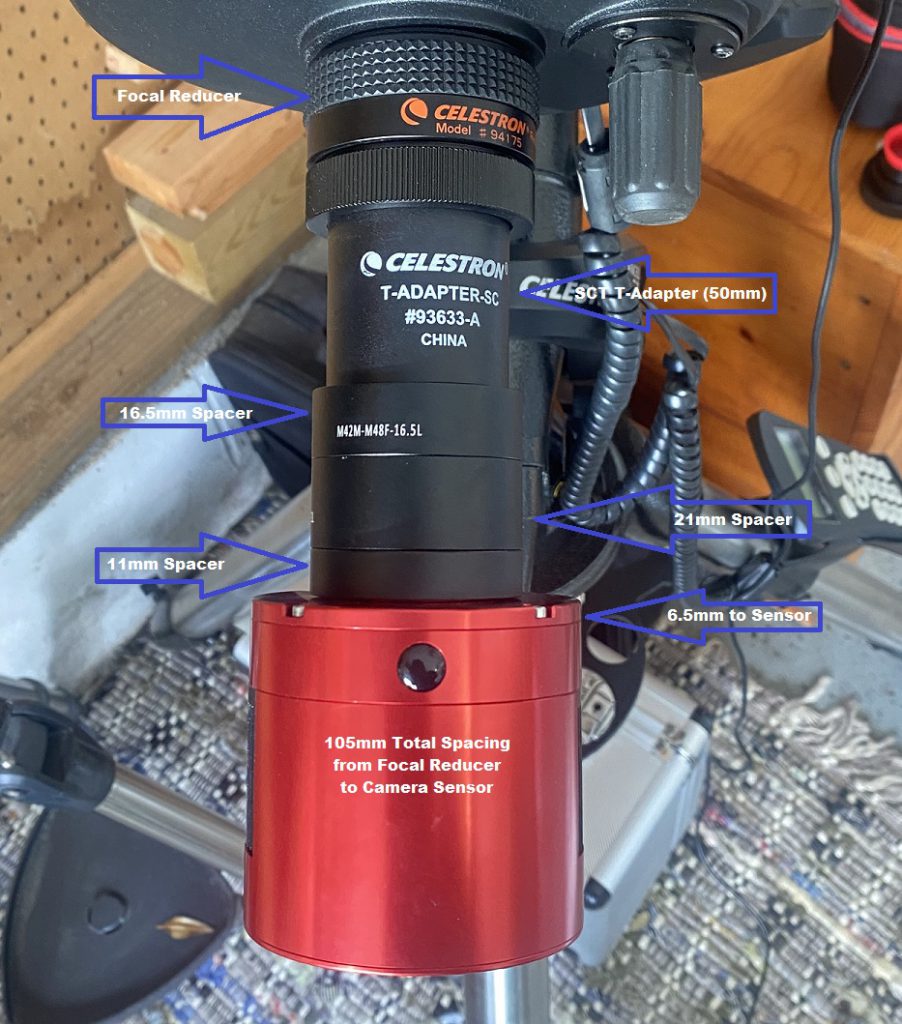
There is an m48 to m42 adapter in the 16.5mm spacer to match the m42 threads on the SCT T-Adapter (93633-A).
This spacing should get me to F/6.3 but plate solving is calculating the actual focal length of the 6″ SCT at ~1069mm for a focal ratio to F/6.9. I have not tinkered with adding any more spacing to get try to get to the full F/6.3 reduction.
Using the F/6.3 focal reducer on the 6″ SCT with the ASI294 camera produces a bit of vignetting and coma to the edge of the image, especially towards the corners. Doesn’t really bother me for EAA when I am focused on observing the object in the center of the FOV but it can distort interesting objects out toward the edge of the FOV. Less than 105mm will result in less reduction and probably less distortion at the edge, more spacing will provide more reduction and likely more distortion to the edge.
The spacers I am using all came with the ZWO ASI 294MC Pro Camera, but you can find inexpensive spacer sets on Amazon like this M42 set from SVBONY.
Hope you found this helpful, any questions or tips please drop them in the comments. Clear skies.


